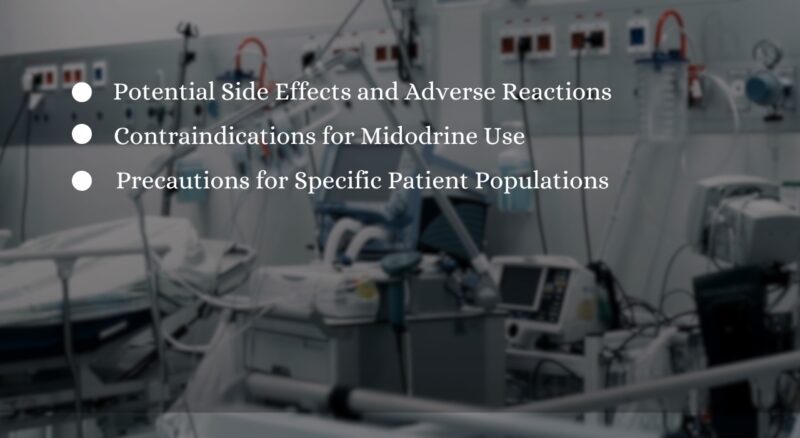Midodrine is a vasopressor and antihypotensive agent, meaning it raises blood pressure. It was approved by the Food and Drug Administration (FDA) in the United States in 1996 for the treatment of dysautonomia and orthostatic hypotension.
A prodrug that forms an active metabolite, desglymidodrine, which acts on the alpha-adrenergic receptors of the arteriolar and venous vasculature, increasing vascular tone and blood pressure.
Why Midodrine is Used in the ICU

In the Intensive Care Unit (ICU), the drug is utilized to manage blood pressure, particularly in cases of symptomatic orthostatic hypotension. It can reduce dizziness and fainting by about a third, though it may cause side effects like goosebumps, skin itch, gastrointestinal discomfort, and elevated blood pressure while lying down.
Managing blood pressure is vital in critical care settings, as fluctuations can lead to serious complications. Its ability to raise blood pressure makes it a valuable tool in the ICU, especially for patients with low blood pressure when standing, a condition known as neurogenic orthostasis.
The Mechanism of Action of Midodrine
How it Works to Raise Blood Pressure
It forms an active metabolite, desglymidodrine, which acts on the alpha-adrenergic receptors of the blood vessels. This action leads to an increase in vascular tone and elevation of blood pressure.
Interaction with the Autonomic Nervous System
Desglymidodrine, the active metabolite of Midodrine, exerts its actions via activation of the alpha-adrenergic receptors of the arteriolar and venous vasculature. Unlike other agents, it does not stimulate cardiac beta-adrenergic receptors, and it diffuses poorly across the blood-brain barrier, so it’s not associated with central nervous system effects.
Effects on Blood Vessels and Peripheral Resistance
Midodrine’s action on the alpha-adrenergic receptors leads to constriction of blood vessels, thereby increasing peripheral resistance. This results in a rise in blood pressure, making it a useful agent in treating hypotension.
Clinical Uses of Midodrine in the ICU

- Hypotension in Critically Ill Patients: Used to treat symptomatic orthostatic hypotension in critically ill patients, reducing symptoms like dizziness and fainting.
- Septic Shock and Other Vasodilatory Conditions: Though primarily indicated for orthostatic hypotension, it has been explored in the treatment of septic shock and other vasodilatory conditions, where it may help in maintaining blood pressure.
- Postoperative Hypotension: Small studies have shown that it can be used to prevent excessive drops in blood pressure in people requiring dialysis, making it potentially useful in managing postoperative hypotension.
Administration and Dosage
| Parameter | Details |
| Usual Adult Dose for Hypotension | 10 mg orally 3 times a day during daytime hours |
| Renal Dose Adjustments | CrCl less than 90 mL/min: Initiate with 2.5 mg doses; Contraindicated in acute renal disease |
| Liver Dose Adjustments | Use with caution |
| Monitoring | Supine, standing, and sitting blood pressure; Liver and kidney function |
Recommended Dosage and Titration
Midodrine is typically administered orally for the treatment of symptomatic orthostatic hypotension (OH). The usual adult dose for hypotension is 10 mg, taken three times a day during daytime hours when the patient needs to be upright. The three daily doses may be given at 3-hour intervals if needed, but not more frequently. The drug should not be given after the evening meal or less than 4 hours before bedtime.
Monitoring Blood Pressure During Midodrine Therapy
Regular checks of supine, standing, and sitting blood pressure are required, along with monitoring for signs or symptoms suggestive of bradycardia (e.g., pulse slowing, increased dizziness, syncope, cardiac awareness). Liver and kidney function should also be assessed prior to initial use and thereafter as needed.
Safety and Considerations

Potential Side Effects and Adverse Reactions
Midodrine can cause marked elevation of supine blood pressure. Other side effects may include symptoms of supine hypertension (e.g., cardiac awareness, pounding in the ears, headache, blurred vision), and signs or symptoms suggestive of bradycardia.
Contraindications for Midodrine Use
Midodrine is contraindicated in patients with severe organic heart disease, acute kidney disease, urinary retention, pheochromocytoma, or thyrotoxicosis. It should not be used in patients with persistent and excessive supine hypertension.
Precautions for Specific Patient Populations (e.g., Elderly, Renal Impairment)
For patients with renal impairment (CrCl less than 90 mL/min), treatment should be initiated with lower doses (2.5 mg). Midodrine should be used with caution in patients with liver issues.
Interactions with Other Medications
Specific interactions with common ICU medications are not detailed in the available information. However, patients should be informed that certain components in over-the-counter products (e.g., cold remedies, diet aids) should be used cautiously with Midodrine, as they can also increase blood pressure.
Care should be taken when using Midodrine with other medications that can affect blood pressure. Regular monitoring and consultation with healthcare providers are essential to ensure safe and effective treatment.
Evidence-based Effectiveness
Several clinical studies and trials have been conducted to evaluate the effectiveness of Midodrine in the ICU setting. Some of the notable studies include:
- MIDAS Study: An international randomized clinical trial that investigated the effect of the drug versus placebo on time to vasopressor discontinuation in patients with persistent hypotension in the ICU. The study was conducted across three tertiary referral hospitals in the US and Australia.
- Trends in the ICU: A single-center retrospective case series that examined the use of Midodrine as a vasopressor-sparing agent in the ICU.
- MAVERIC Study: A pilot, feasibility, randomized controlled trial of Midodrine as an adjunctive vasopressor for low-dose vasopressor-dependent hypotension in intensive care patients.
The available studies have shown mixed results in comparing Midodrine with other vasopressors in the ICU. Some studies suggest that it may facilitate weaning off intravenous vasopressors, while others have found no significant difference in outcomes.
Its efficacy in improving patient outcomes in the ICU has been explored, but the evidence is not conclusive. Some studies have found potential benefits in terms of reducing the time to vasopressor discontinuation, while others have not found significant associations with improved outcomes.
FAQ
What Are the Main Indications for Using Midodrine in The Icu?
Primarily used for treating persistent hypotension in the ICU, particularly as a vasopressor-sparing agent.
Can Midodrine Be Used in Pediatric ICU Patients?
Information specific to pediatric ICU use is limited, and consultation with healthcare providers is recommended.
Are There Any Specific Contraindications for Midodrine Use?
Contraindications include severe organic heart disease, acute kidney disease, urinary retention, pheochromocytoma, thyrotoxicosis, and persistent and excessive supine hypertension.
How Quickly Does Midodrine Take Effect in Raising Blood Pressure?
Its effects on blood pressure may vary, and individualized monitoring is essential.
Can Midodrine Be Used in Patients with Cardiac Conditions?
Should be used with caution in patients with severe organic heart disease.
What Are the Common Side Effects of Midodrine in The Icu?
Common side effects include elevation of supine blood pressure, cardiac awareness, pounding in the ears, headache, and blurred vision.
Is Midodrine Safe for Long-Term Use in Critically Ill Patients?
Long-term safety in critically ill patients requires further investigation and individualized care.
How Does Midodrine Compare to Other Vasopressors in Terms of Effectiveness?
Comparative effectiveness with other vasopressors varies, and more research is needed.
Are There Any Special Considerations for Administering Midodrine Intravenously?
Typically administered orally, and intravenous administration is not standard.
What Monitoring Parameters Are Important During Midodrine Therapy in The Icu?
Monitoring of supine, standing, and sitting blood pressure, liver and kidney function, and signs of bradycardia is essential.
Conclusion
Midodrine has emerged as a valuable tool in the ICU for managing persistent hypotension. Its role as a vasopressor-sparing agent and potential benefits in facilitating weaning off intravenous vasopressors have been explored. However, more research is needed to fully understand its comparative effectiveness and long-term safety.
The ongoing exploration of Midodrine in the ICU setting opens doors for potential advancements in critical care pharmacotherapy. Continued research, clinical trials, and real-world applications will contribute to a deeper understanding of its role and pave the way for innovative approaches in critical care management.
